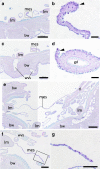Regeneration of the digestive tract of an anterior-eviscerating sea cucumber, Eupentacta quinquesemita, and the involvement of mesenchymal-epithelial transition in digestive tube formation
- PMID: 31285838
- PMCID: PMC6588844
- DOI: 10.1186/s40851-019-0133-3
Regeneration of the digestive tract of an anterior-eviscerating sea cucumber, Eupentacta quinquesemita, and the involvement of mesenchymal-epithelial transition in digestive tube formation
Abstract
Sea cucumbers (a class of echinoderms) exhibit a high capacity for regeneration, such that, following ejection of inner organs in a process called evisceration, the lost organs regenerate. There are two ways by which evisceration occurs in sea cucmber species: from the mouth (anterior) or the anus (posterior). Intriguingly, regenerating tissues are formed at both the anterior and posterior regions and extend toward the opposite ends, and merge to form a complete digestive tract. From the posterior side, the digestive tube regenerates extending a continuous tube from the cloaca, which remains at evisceration. In posteriorly-eviscerating species, the esophagus remains in the body, and a new tube regenerates continuously from it. However, in anterior-eviscerating species, no tubular tissue remains in the anterior region, raising the question of how the new digestive tube forms in the anterior regenerate. We addressed this question by detailed histological observations of the regenerating anterior digestive tract in a small sea cucumber, Eupentacta quinquesemita ("ishiko" in Japanese) after induced-evisceration. We found that an initial rudiment consisting of mesenchymal cells is formed along the edge of the anterior mesentery from the anterior end, and then, among the mesenchymal cells, multiple clusters of epithelial-like cells appears simultaneously and repeatedly in the extending region by mesenchymal-epithelial transition (MET) as visulalized using toluidine blue staining. Subsequently, multiple cavities were formed surrounded with these epithelial cells, and appeared to coalesce with each other to form into multiple lumens, and to eventually become a single tube. This anterior tube then fused to the tube regenerated from the posterior rudiment. Thus, we elucidated the process of regeneration of the anterior portion of the gut in an anteriorly eviscerating species, and suggest the involvement of MET and fusion of cavities/lumens in regeneration of the digestive tube.
Keywords: Digestive tract; Echinoderm; Evisceration; Mesenchymal–epithelial transition; Mesentery; Regeneration; Sea cucumber.
Conflict of interest statement
Competing interestsThe authors declare that they have no competing interests.
Figures









Similar articles
-
A Review of Histocytological Events and Molecular Mechanisms Involved in Intestine Regeneration in Holothurians.Biology (Basel). 2022 Jul 22;11(8):1095. doi: 10.3390/biology11081095. Biology (Basel). 2022. PMID: 35892951 Free PMC article. Review.
-
Posterior regeneration following fission in the holothurian Cladolabes schmeltzii (Dendrochirotida: Holothuroidea).Microsc Res Tech. 2015 Jul;78(7):540-52. doi: 10.1002/jemt.22507. Epub 2015 Apr 29. Microsc Res Tech. 2015. PMID: 25921295
-
Post-autotomy regeneration of respiratory tree in sea cucumber Holothuria parva.J Exp Zool B Mol Dev Evol. 2022 May;338(3):155-169. doi: 10.1002/jez.b.23109. Epub 2021 Nov 23. J Exp Zool B Mol Dev Evol. 2022. PMID: 34813182
-
Anterior regeneration after fission in the holothurian Cladolabes schmeltzii (Dendrochirotida: Holothuroidea).Microsc Res Tech. 2017 Feb;80(2):183-194. doi: 10.1002/jemt.22786. Epub 2016 Oct 7. Microsc Res Tech. 2017. PMID: 27717203
-
Visceral regeneration in holothurians.Microsc Res Tech. 2001 Dec 15;55(6):438-51. doi: 10.1002/jemt.1189. Microsc Res Tech. 2001. PMID: 11782073 Review.
Cited by
-
Beyond Adult Stem Cells: Dedifferentiation as a Unifying Mechanism Underlying Regeneration in Invertebrate Deuterostomes.Front Cell Dev Biol. 2020 Oct 20;8:587320. doi: 10.3389/fcell.2020.587320. eCollection 2020. Front Cell Dev Biol. 2020. PMID: 33195242 Free PMC article. Review.
-
From fragment to form: whole-body regeneration in a model urochordate.NPJ Regen Med. 2025 Aug 1;10(1):36. doi: 10.1038/s41536-025-00423-0. NPJ Regen Med. 2025. PMID: 40750611 Free PMC article. Review.
-
A Review of Histocytological Events and Molecular Mechanisms Involved in Intestine Regeneration in Holothurians.Biology (Basel). 2022 Jul 22;11(8):1095. doi: 10.3390/biology11081095. Biology (Basel). 2022. PMID: 35892951 Free PMC article. Review.
-
The Use of Larval Sea Stars and Sea Urchins in the Discovery of Shared Mechanisms of Metazoan Whole-Body Regeneration.Genes (Basel). 2021 Jul 13;12(7):1063. doi: 10.3390/genes12071063. Genes (Basel). 2021. PMID: 34356079 Free PMC article. Review.
-
Mesentery AjFGF4-AjFGFR2-ERK pathway modulates intestinal regeneration via targeting cell cycle in echinoderms.Cell Prolif. 2023 Feb;56(2):e13351. doi: 10.1111/cpr.13351. Epub 2022 Oct 20. Cell Prolif. 2023. PMID: 36263902 Free PMC article.
References
-
- Arnone MI, Byrne M, Martinez P. Echinodermata. In: Wanninger A, editor. Evolutionnary developmental biology of invertebrates: 6 Deuterostomia. 2015. pp. 1–58.
LinkOut - more resources
Full Text Sources
Miscellaneous

